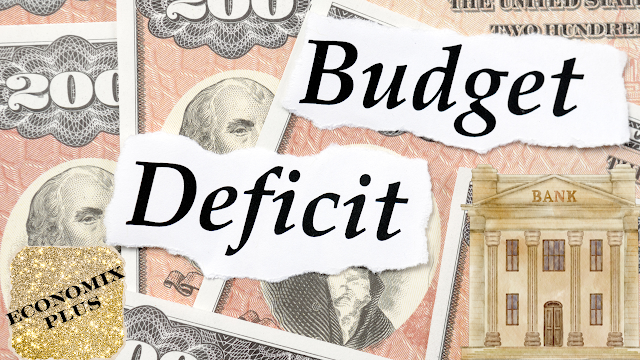Understanding the Connection Between Central Banks and Fiscal Deficits
A government’s fiscal deficit occurs when its expenditures exceed its revenues, often leading to borrowing to cover the shortfall. The fiscal deficit is a critical indicator of a government’s economic health and its ability to manage public finances. While the fiscal deficit itself is a government issue, the central bank plays an essential role in managing and addressing the implications of such deficits.
In this article, we will explore the relationship between the central bank and the government fiscal deficit, including how central bank policies can influence government debt and what tools the central bank uses to manage or mitigate fiscal deficits.
1. “What is a Fiscal Deficit?”
Before diving into the relationship between the central bank and the fiscal deficit, it’s essential to understand what a fiscal deficit is. A fiscal deficit occurs when a government’s annual expenditure surpasses its total revenue. This shortfall often leads to the need for borrowing, either from domestic or international sources, to cover the gap.
While a fiscal deficit is a natural part of managing a country’s economy, excessive deficits can lead to higher government debt and potential inflationary pressures, making it crucial for governments to manage deficits responsibly.
2. “The Role of the Central Bank in the Economy”
The central bank is a key institution responsible for managing a country’s monetary policy, regulating the money supply, and ensuring economic stability. Some of the primary functions of the central bank include:
– “Control of Inflation:” By managing interest rates and money supply, the central bank controls inflation levels, which can be affected by a high fiscal deficit.
– “Monetary Policy Implementation:” The central bank adjusts interest rates and conducts open market operations to influence economic conditions, including economic growth and government debt.
– “Regulation of the Banking System:” The central bank ensures financial stability and supervises the banking system to avoid financial crises.
Given these responsibilities, the central bank is closely connected to government fiscal policies, especially when dealing with fiscal deficits and government debt.
3. “How Central Banks Influence Fiscal Deficits”
1. “Monetary Policy and Interest Rates”
Central banks control interest rates, which directly affect government borrowing costs. When a government is running a fiscal deficit, it often needs to borrow money to finance the gap. The central bank’s policies on interest rates can influence the cost of this borrowing.
– “Low Interest Rates“: If the central bank lowers interest rates, borrowing becomes cheaper for the government. This can help reduce the burden of a fiscal deficit, especially if the government needs to issue bonds or take loans to cover the shortfall.
– “High Interest Rates“: Conversely, if the central bank raises interest rates to control inflation, government borrowing becomes more expensive, which can exacerbate the fiscal deficit. Higher borrowing costs can lead to a vicious cycle where the government needs to borrow more to service existing debt.
Therefore, the central bank’s monetary policy decisions directly impact the fiscal deficit and government borrowing costs.
2. “Quantitative Easing (QE) and Government Debt”
During times of economic crisis or stagnation, central banks may resort to “quantitative easing (QE)” as a tool to stimulate the economy. In a QE program, the central bank buys government bonds and other financial assets to increase the money supply and lower long-term interest rates.
– “Impact on Fiscal Deficit“: By purchasing government debt, the central bank essentially finances the fiscal deficit indirectly. This can help the government manage its debt obligations without increasing borrowing costs. However, this process can lead to an increase in the money supply, which could eventually cause inflation.
While QE provides temporary relief to governments running large fiscal deficits, it may create long-term risks, including inflation or asset bubbles, that could harm economic stability.
4. “The Central Bank’s Role in Government Debt Management”
The central bank and the government work closely in managing national debt. The central bank often helps the government by acting as a buyer of last resort for government bonds, especially when the government faces challenges in attracting buyers for its debt.
– “Debt Monetization“: In some cases, the central bank may directly finance government deficits by purchasing government bonds. This process, known as “debt monetization“, can increase the money supply, potentially leading to inflation. While this provides short-term relief, excessive monetization can undermine the value of the currency and lead to high inflation.
– “Government Bonds and Inflation“: If the central bank purchases government bonds to fund fiscal deficits, it can lead to inflationary pressures. Excessive borrowing, whether domestic or through central bank purchases, can increase the money supply, causing inflationary expectations to rise.
Therefore, the central bank’s involvement in debt management is crucial, but it requires careful balance to avoid triggering inflation or devaluing the currency.
5. “The Risks of High Fiscal Deficits and Central Bank Intervention”
While the central bank can support the government during periods of fiscal deficit, there are risks involved:
– “Inflationary Pressures“: The central bank’s efforts to ease fiscal deficits by lowering interest rates or engaging in QE can result in higher inflation, especially if economic growth doesn’t keep up with the increase in money supply.
– “Debt Sustainability“: Constant reliance on central bank financing can lead to “unsustainable debt levels“. If the government continues to run high fiscal deficits without addressing the root causes of the deficit, this could lead to a growing debt burden that becomes harder to manage over time.
– “Currency Depreciation“: Excessive government borrowing and central bank interventions could lead to the depreciation of the national currency, especially if there are concerns about the country’s ability to repay its debt.
Thus, while the central bank can provide short-term solutions to fiscal deficits, it is important for the government to address the underlying causes of the deficit to ensure long-term economic stability.
6. “A Complex Relationship”
The relationship between the central bank and government fiscal deficits is complex and involves various mechanisms, such as interest rates, government debt management, and monetary policy tools like quantitative easing. While the central bank plays a supportive role in managing fiscal deficits, its actions must be carefully calibrated to avoid inflationary pressures, currency depreciation, and unsustainable debt levels.
In the end, the central bank’s primary responsibility is to maintain economic stability, while the government must manage its fiscal policy to ensure that deficits are sustainable and do not lead to long-term economic challenges. Coordination between the central bank and the government is crucial to achieving balanced fiscal and monetary policies that promote growth and stability.
“Actionable Summary”
– ✅ Central banks influence fiscal deficits through interest rates and debt management.
– ✅ Low interest rates can reduce borrowing costs for the government, while high interest rates can increase them.
– ✅ Quantitative easing can help manage government debt but may lead to inflationary pressures.
– ✅ The central bank must carefully balance its interventions to avoid long-term economic instability.
Understanding the central bank’s role in managing fiscal deficits helps policymakers make informed decisions for economic stability and sustainable growth.













